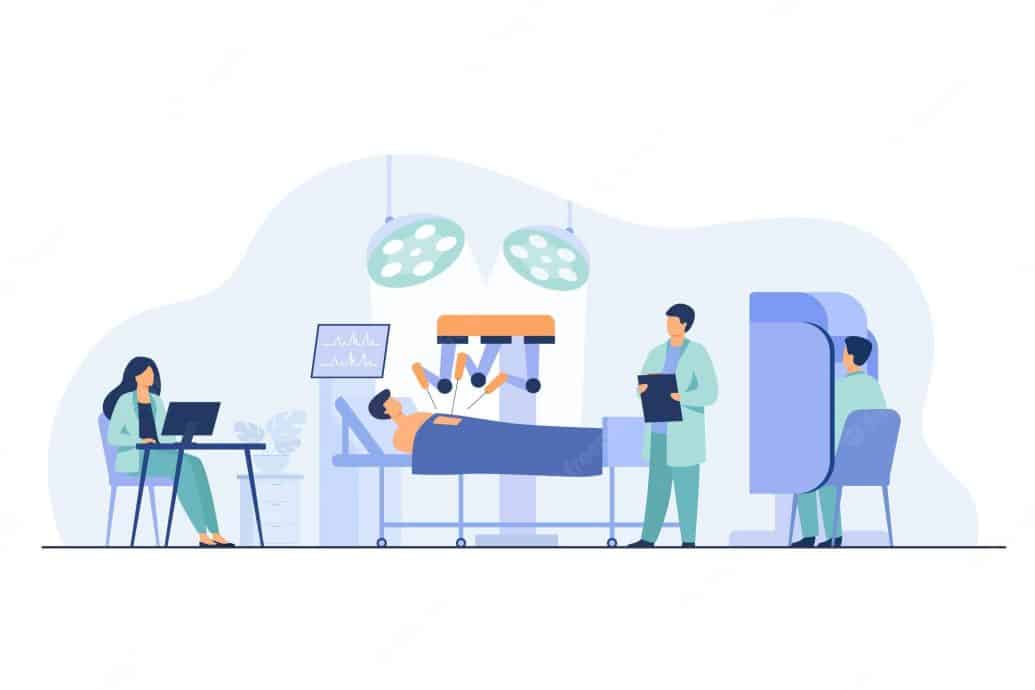Introduction: Robotic Surgery
Robotic surgery is a surgical procedure that uses a robotic arm to manipulate surgical instruments. The procedure is performed through small incisions, resulting in less pain and scarring than traditional surgery.
Also Read: First Robotic Surgery
From gynecologic surgeries to heart incisions, robotic and AI based surgery can perform a wide variety of tasks. Let’s take a closer look.
The Lindbergh Operation and Remote Surgery
The first transatlantic surgery was performed in 2001. French surgeons based in New York remotely removed a patient’s gallbladder in Strasbourg, France! The operation took less than an hour, and the patient was successfully discharged two days later.
Also Read: First AI designed drug in human trials.
The revolutionary surgeons used the ZEUS robotic surgical system developed by the Californian company Computer Motion. The ZEUS system consisted of a surgeon’s console and a robotic arm that the surgeons could use to control the instruments.
Source: YouTube
The Lindbergh Operation, as it came to be known, was a watershed moment in the history of robotic surgery. It showed that surgeons could perform complex procedures remotely without being in the same room as the patient.
Also Read: Impact Of Automation In Healthcare
What are the advantages of robotic surgery?
Robotic surgery has several benefits over traditional surgery, including:
Minimal scarring
Perhaps the most significant benefit of using this system is that it is minimally invasive. That means that the incisions are tiny, resulting in less pain and scarring than traditional surgery.
Also Read: The Impact of Artificial Intelligence in Ophthalmology
This benefit is especially important for procedures performed on conscious areas such as the face or breasts. Robotic surgery can help patients avoid the telltale scars that often remain after traditional surgery.
Increased precision
Human error is inevitable, and in a fragile organ like the human heart, even the slightest mistake can be catastrophic. That’s why robotic surgery is so valuable; it offers surgeons unparalleled precision and accuracy.
Also Read: The role of AI in vaccine distribution
Reduced recovery time
Another advantage of these procedures is that patients typically recover faster. Once again, the minimally invasive nature of robotic surgery reduces inflammation and swelling.
Source: YouTube
Increase field of view for surgeon
Not only do the patients benefit from robotic surgery, but it also gives surgeons a much wider field of view than they would have with traditional surgery.
Also Read: Artificial Intelligence and Otolaryngology.
This enhanced visual field is due to the miniature camera built into the robotic surgical system. This camera sends a live feed to the surgeon’s console, allowing them to see the surgical area in great detail.
You can imagine how this might help a delicate operation in a tough spot like the rectum or intestines.
Also Watch: Healed through A.I. | The Age of A.I. | S1 | E2
The robotic surgical system doesn’t shake when it’s nervous or gets tired like a human surgeon might. This ensures that the surgical instruments are always in the same position, regardless of the surgeon’s fatigue or unsteadiness.
Reduced risk of infection
Robotic surgery also offers a lower risk of infection than traditional surgery because the mechanical surgical system is completely sterile, minimizing the risk of contamination.
Also Read: How Hospitals Use Algorithms to Prioritize COVID-19 Vaccine Distribution
The reduced risk works both ways. After seeing the COVID-19 pandemic unfold and sweep through hospital floors, we can understand that the surgeon remotely controlling a robot would undoubtedly reduce both parties’ exposure to the virus.
How will robotic surgery transform healthcare?
The benefits of using robots in surgery are clear, and it’s no wonder that the technology is swiftly transforming healthcare. In the coming years, this method will become the standard of care for a wide range of procedures.
Also Read: The Role of Artificial Intelligence in Healthcare Documentation
This will not only improve patient outcomes but will also help to reduce healthcare costs. Robotic surgery is more efficient than traditional surgery, and this efficiency will lead to reduced wait times and shorter hospital stays.
Patients will benefit from increased accuracy and precision, and surgeons will benefit from reduced pressure and fatigue. In short, robotic surgery is changing the face of healthcare for the better. We can’t wait to see what the future holds.
Also Read: Image Annotations: For AI driven Skin Conditions Diagnosis
Artificial intelligence
Robotic arms are not new, as we can see from the 2001 transatlantic surgery. However, what is new is the advent of artificial intelligence (AI) in robotic surgery. AI can help to reduce the surgeon’s workload further and improve accuracy and precision.
Also Read: Artificial Intelligence in Healthcare Business Process Improvement
For example, AI can identify and correct errors in surgical procedures. It can also help the surgeon plan the surgery and select the best surgical instruments for the job.
AI is even being used to create “virtual surgery” simulations. These simulations allow surgeons to practice complex and specific procedures before performing them on a live patient. Using this “practice round” reduces the risk of error and helps to ensure that the surgery is successful.
Conclusion
Robotic surgery is a transformative technology that is quickly changing the face of healthcare. It offers patients many advantages, including reduced recovery time, lighter scarring, and increased precision.
Also Read: How can Artificial Intelligence help with the Coronavirus (Covid-19) vaccine search?
As technology continues to develop, we can expect even more amazing things from advanced AI based surgery. It is poised to streamline the healthcare system, taking care of repetitive or strenuous tasks so that surgeons can focus on the patient.
